V838 Monocerotis (Nova Monocerotis 2002) is a red supergiant located approximately 19,200 light-years away in the constellation Monoceros. It lies at the outer edge of the Milky Way. In 2002, the supergiant experienced an outburst and briefly became one of the largest stars known. It was the first star to be classified as a luminous red nova.
Star system
V838 Monocerotis is a spectroscopic binary star composed of a cool red supergiant and close blue companion star. The supergiant has the stellar type M5.5I and the companion is a main sequence star of the spectral type B3 V.
The supergiant star has a mass of 5 – 10 solar masses and a radius 467 times that of the Sun. With an effective temperature of 3,300 K, it is 23,000 times more luminous than the Sun. It has an estimated age of only 4 million years.
V838 Monocerotis was the first star to be classified as a luminous red nova (LRN). Luminous red novae are eruptive events produced by stellar mergers. They are not related to regular novae, which occur when white dwarfs accrete matter from a binary companion. V838 Mon is too young and there has not been enough time for a white dwarf to form, cool and accrete enough matter to produce the outburst event.
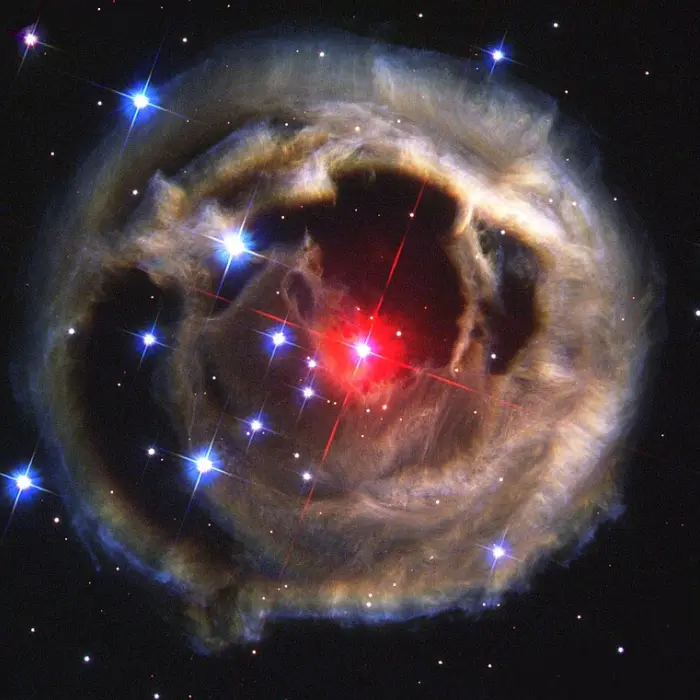
In January 2002, a dull star in an obscure constellation suddenly became 600,000 times more luminous than our Sun, temporarily making it the brightest star in our Milky Way galaxy. The mysterious star, called V838 Monocerotis, has long since faded back to obscurity. But observations by NASA’s Hubble Space Telescope of a phenomenon called a “light echo” around the star have uncovered remarkable new features. These details promise to provide astronomers with a CAT-scan-like probe of the three-dimensional structure of shells of dust surrounding an aging star. Image credit: NASA, ESA and H.E. Bond (STScI) (PD)
Nova Monocerotis 2002
V838 Monocerotis was a faint, unknown star until it was observed to dramatically brighten on January 6, 2002. The brightening was caused by an outburst on one of the two B3-type main sequence stars in a close orbit.
At first, the event appeared to be a nova, an eruption triggered when a white dwarf accretes enough hydrogen gas from a close companion. The system was named Nova Monocerotis 2002.
However, observations revealed that Nova Monocerotis 2002 was not a nova at all, but a merger of two B-type stars in a triple star system. The star that experienced the eruption had the spectrum of an unusually cool supergiant. For a time, it engulfed its binary companion.
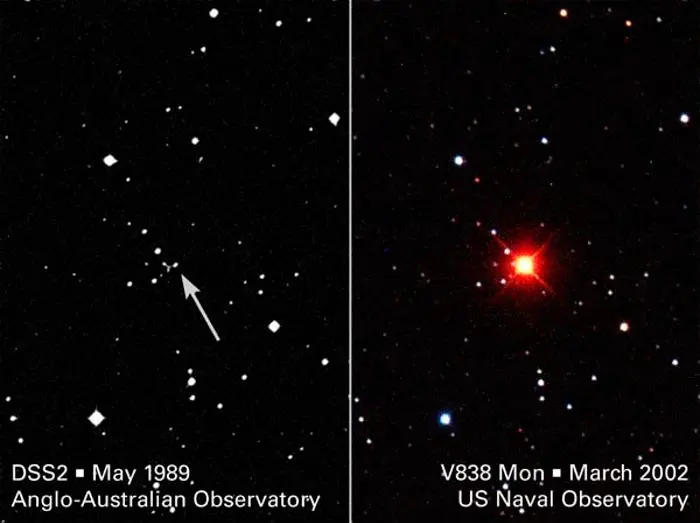
These two images compare V838 Mon before (May 1989) and after the outburst (March 2002). Image credit: NASA/ESA, Anglo-Australian Observatory, U.S. Naval Observatory and Z. Levay (STScI) (PD)
Other explanations for the event suggest that V838 Mon may have swallowed its giant planets or that it may have been a very massive supergiant undergoing a helium flash, a thermonuclear event that ignites helium fusion in the core of an evolved star.
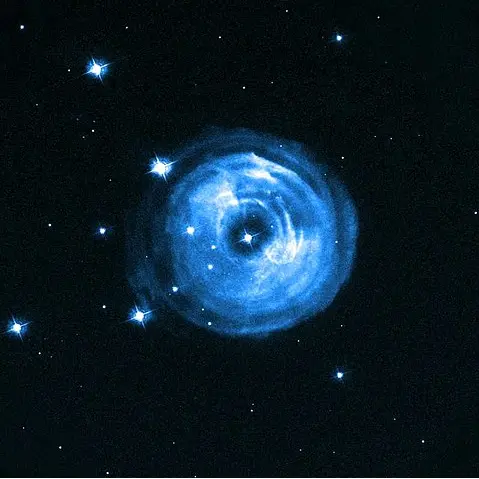
Light echo around the Star V838 Monocerotis. Image credit: NASA, ESA and H.E. Bond (STScI) (PD)
At its peak brightness, V838 Monocerotis shone at magnitude 6.75, staying below unaided eye visibility. The brightening was the result of the star’s outer layers rapidly expanding. The star system reached the visual maximum on February 6, 2002. It then started to rapidly dim but then brightened again in early March. The brightening was particularly evident in infrared wavelengths in March and then again in early April.
At its peak, V838 Monocerotis shone with a luminosity of about a million Suns and had an absolute magnitude of -9.8. It was one of the most luminous stars in our galaxy.
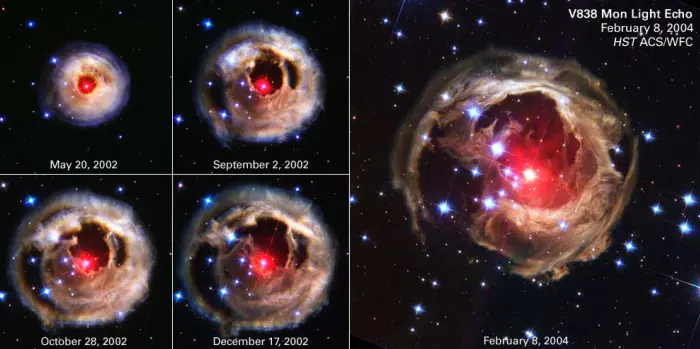
Successive photos of V838 Monocerotis showing the progress of a light echo. Image credit: NASA, ESA, H.E. Bond (STScI) and The Hubble Heritage Team (STScI/AURA) (PD)
By 2003, the star dimmed to magnitude 15.6, similar to its original brightness before the outburst, but now it had the spectrum of a red supergiant and not a hot blue main sequence star.
Some astronomers suggested that the spectrum of V838 Mon was initially similar to those of L-type brown dwarfs. This would make V838 Mon the first “brown” supergiant known.
In 2004, observations with the Palomar Testbed Interferometer yielded a radius of 1,570 ± 400 solar radii for the star, comparable to the orbit of Jupiter in the solar system. Later that year, measurements of the star’s angular diameter indicated a physical radius of 1,200 ± 150 solar radii.
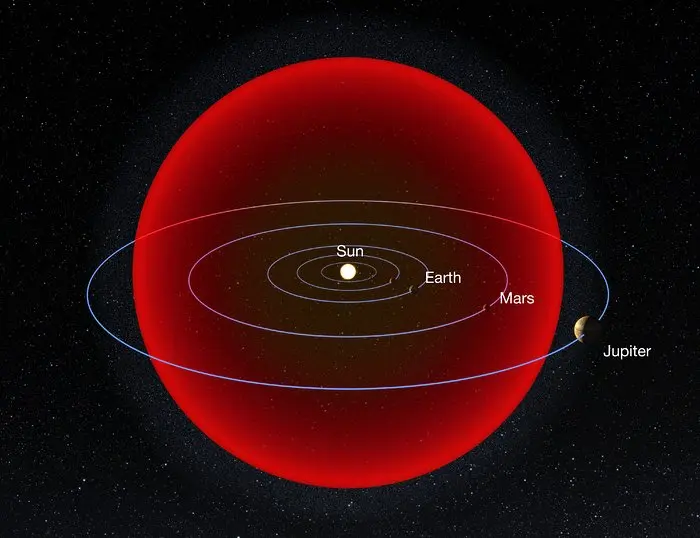
Diagram showing a comparison between the size of star V838 Monocerotis at its fullest and our Solar System. Image credit: NASA/ESA and A. Feild (STScI) (CC BY 4.0)
In 2009, spectroscopic observations of V838 Monocerotis with the UVES spectrograph on the Very Large Telescope (VLT) revealed the spectrum of an M6 giant or supergiant and a complete absence of the B-type companion. Astronomers proposed that the companion likely entered the V838 Mon remnant and became completely engulfed in it.
By 2014, the star’s radius shrunk to 750 ± 200 solar radii, about 70 R☉ larger than the red supergiant Antares in the constellation Scorpius.
The temperature of V838 Monocerotis increased to 3,270 K by 2009, corresponding to a luminosity of 15,000 times that of the Sun. Without interstellar extinction, this would correspond to a visual magnitude of 8.5.
In 2021, observations with the Atacama Large Millimeter/submillimeter Array (ALMA) yielded a radius of 464 solar radii. Astronomers also found that the companion, which is separated by 250 astronomical units from the supergiant, is heavily interacting with the merger ejecta and changing its chemical composition due to circumstellar shocks.
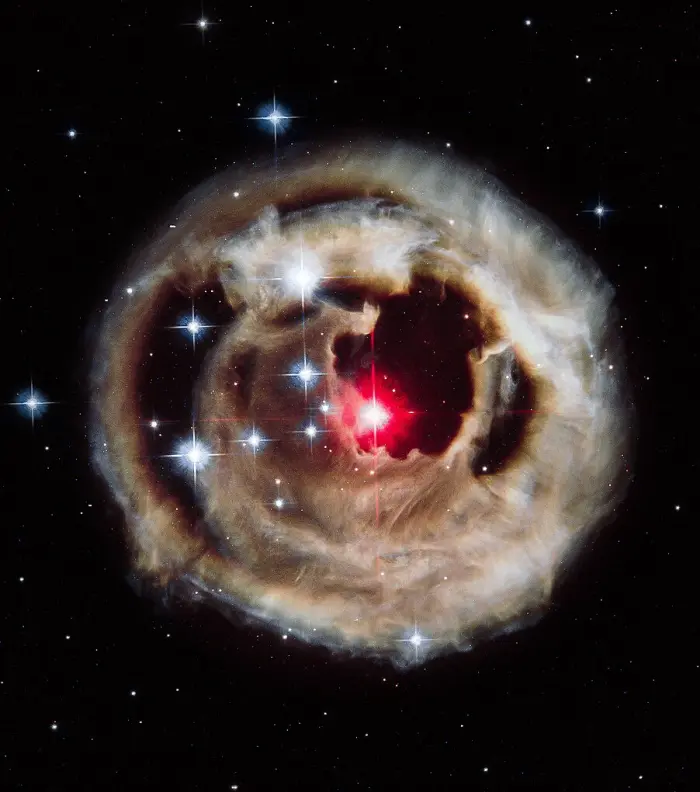
V838 Monocerotis captured by the Hubble Space Telescope (HST), image credit: NASA/ESA/Hubble Team/Kevin M. Gill (CC BY 2.0)
Light echo
V838 Monocerotis is surrounded by a spectacular light echo, an expanding halo of light that was produced when the star erupted in 2002. Some of the light from the star scatters (“echoes”) off the interstellar dust before it travels to Earth and reaches our planet tens of thousands of years after the eruption.
The presence of the surrounding dust suggests that the star previously experienced other eruptions. However, other evidence indicates that the star is still very young and surrounded by the clouds of dust and gas in which it formed. Other studies show that the dust is interstellar and not related to V838 Mon.
Light echoes are produced by rapidly brightening objects such as supernovae and novae. The relatively unobscured light that travels directly from V838 Mon arrives to Earth first. Some of the star’s light is reflected from the clouds and arrives later, creating an appearance of expanding rings of light around the star. The geometries of light echoes can produce the illusion that the rings travel faster than the speed of light when they really do not.
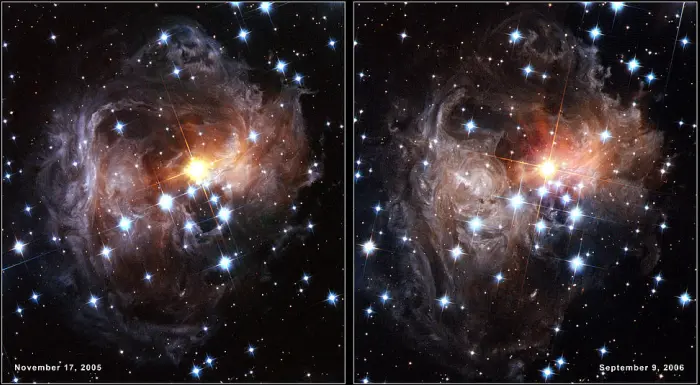
These images show the evolution of the light echo around the star V838 in the constellation of Monoceros. They were taken by the Hubble Advanced Camera for Surveys in November 2005 (left) and again in September 2006 (right). The numerous whorls and eddies in the interstellar dust are particularly noticeable. Possibly they have been produced by the effects of magnetic fields in the space between the stars. Image credit: NASA, ESA and H. Bond (STScI) (PD)
When V838 Monocerotis erupted in 2022, the outburst appeared to expand from 4 to 7 light-years across in a matter of months, producing the illusion that it was expanding at superluminal speeds.
The light echo of V838 Monocerotis has been captured by the Hubble Space Telescope (HST) on multiple occasions since the eruption. The images appear to show an expanding shell of material, but they really depict the illumination of an expanding ellipsoid.
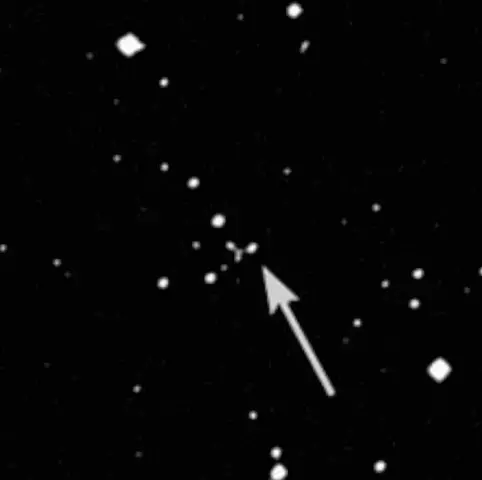
Animation of 11 images found at esahubble.org. Image: ESA, NASA, Hubble, Wikimedia Commons/Lasunncty (CC BY 4.0)
Facts
Outbursts similar to that of V838 Monocerotis were observed in 1988, 1994, and 2008.
In 1988, the red supergiant M31-RV in the Andromeda Galaxy (Messier 31) experienced an outburst that was classified as a luminous red nova. It reached an absolute visual magnitude of -9.8 and peaked at magnitude 17 before rapidly fading.
In 1994, V4332 Sagittarii peaked at magnitude 8.9 during an outburst and then rapidly declined in brightness and changed spectral type over a period of only five days.
In 2008, the contact binary system V1309 Scorpii produced a luminous red nova when the components merged into a single star.
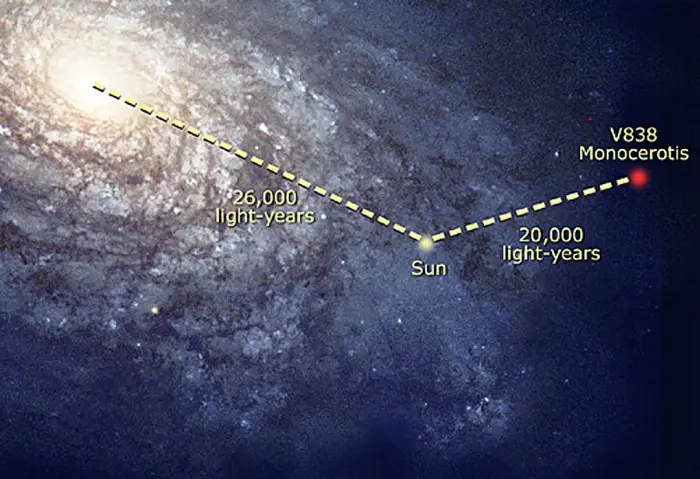
Location of V838 Mon in the Milky Way Galaxy. Image credit: NASA/ESA, A. Feild (STScI) and the Hubble Heritage Team (AURA/STScI) (PD)
Name
V838 Monocerotis does not have a proper name. It was given the variable star designation V838 Monocerotis as the 838th variable star in the constellation Monoceros after its outburst in 2002. It was also designated Nova Monocerotis 2002 because its initial light curve appeared similar to that of a nova.
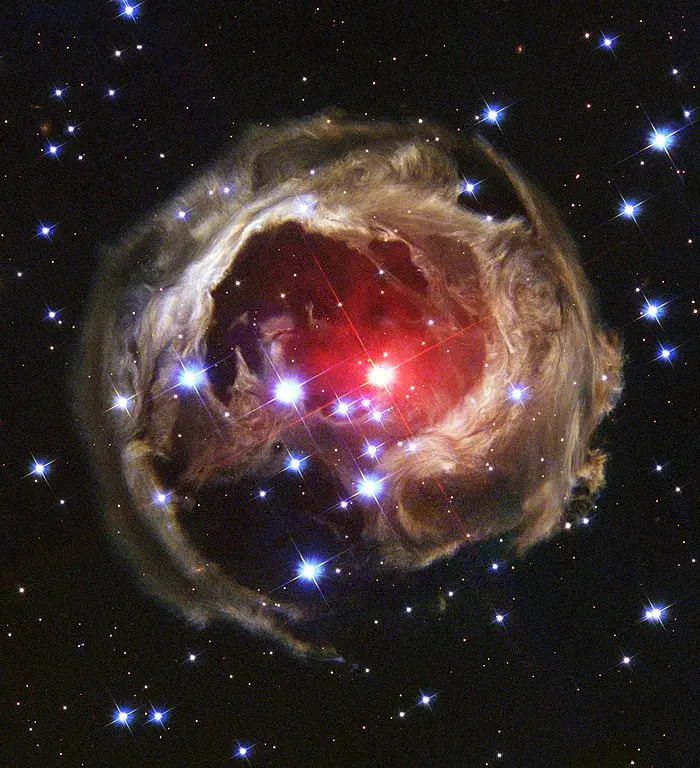
A halo of light surrounds an unusual, variable star called V838 Monocerotis (V838 Mon). Called a light echo, the expanding illumination of interstellar dust around the star has been revealing remarkable structures in the dusty cloud ever since the star suddenly brightened in January 2002. V838 Mon temporarily became 600,000 times brighter than our Sun, until it faded in April 2002. It was one of the brightest stars in the entire Milky Way. The reason for the eruption is still unclear. The red supergiant star, seen in the middle of the image, is located about 20,000 light-years away from Earth in the direction of the constellation Monoceros, at the outer edge of our Milky Way Galaxy. The star has some similarities to a class of objects called “novae,” which suddenly increase in brightness due to thermonuclear events at their surfaces. However, the detailed behavior of V838 Mon, in particular its extremely red color, has been completely different from any previously known nova. Hubble has observed the V838 Mon light echo several times since 2002. Light from V838 Mon continues propagating outward. Each new observation of the light echo reveals a new and unique “thin-section” through the interstellar dust around the star. Scientists have been studying the structure of V838 Mon to understand the distribution of dust revealed by the echo, and to determine what prompted the progenitor star to create the outburst. Image credit: NASA and The Hubble Heritage Team (AURA/STScI) (CC BY 2.0)
Location
V838 Monocerotis lies in the faint constellation of Monoceros. Most of the constellation lies within the Winter Triangle, a bright asterism formed by Sirius in the constellation Canis Major, Betelgeuse in Orion, and Procyon in Canis Minor. V838 Monocerotis can be found roughly halfway between Sirius and Gomeisa, the second brightest star in Canis Minor.
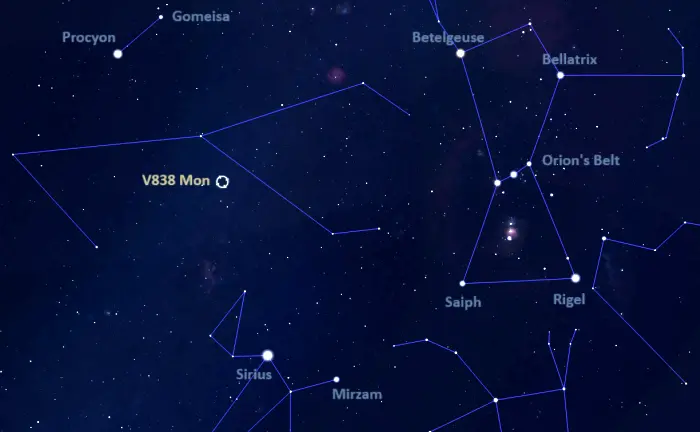
The location of V838 Monocerotis, image: Stellarium
Constellation
V838 Monocerotis is located in the constellation Monoceros. The celestial Unicorn is one of the faintest constellations in the sky. Its brightest star, the hot blue triple star system Beta Monocerotis, has a combined apparent magnitude of 3.74. The yellow giant Alpha Monocerotis and orange giant Gamma Monocerotis are the only other stars in the constellation brighter than magnitude 4.00.
Monoceros is not one of the 48 Greek constellations. It was created by the Dutch astronomer and cartographer Petrus Plancius in 1612.
Other notable stars in the constellation include Plaskett’s Star (V640 Monocerotis), one of the most massive binary stars known, the massive star system S Monocerotis, the brightest member of the Christmas Tree Cluster (NGC 2264), the yellow supergiant Zeta Monocerotis, the white supergiant 13 Monocerotis, and the orange giants 17, 18, and 28 Monocerotis.
Monoceros also contains Scholz’s Star, a faint binary system that passed through the solar system’s Oort cloud about 70,000 years ago, and the binary system A0620-00, which contains one of the nearest stellar-mass black holes to the Sun.
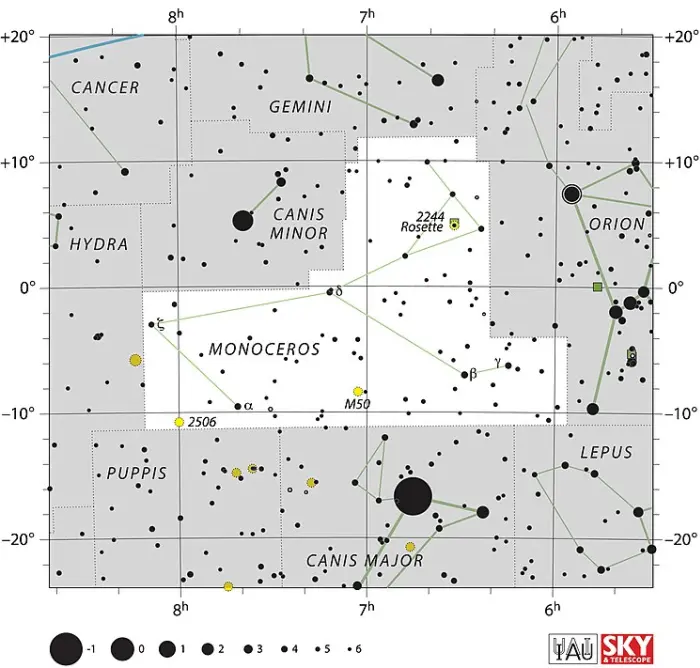
Monoceros constellation map, image: IAU and Sky & Telescope magazine (Roger Sinnott & Rick Fienberg) (CC BY 3.0)
Monoceros is best-known for its bright deep sky objects. The constellation is home to the open cluster Messier 50, the Rosette Nebula (Caldwell 49) with the Satellite Cluster (Caldwell 50), the Cone Nebula with the Christmas Tree Cluster (NGC 2264), the Snowflake Cluster and the Fox Fur Nebula, the reflection nebula IC 2169 (Dreyer’s Nebula), and Hubble’s Variable Nebula (NGC 2261).
The best time of the year to observe the stars and deep sky objects in Monoceros is during the month of February, when the constellation appears higher above the horizon in the early evening. The entire constellation is visible from locations between the latitudes 75° N and 90° S.
The 10 brightest stars in Monoceros are Beta Monocerotis (mag. 3.74), Alpha Monocerotis (mag. 3.94), Gamma Monocerotis (mag. 3.96), Delta Monocerotis (mag. 4.15), Zeta Monocerotis (mag. 4.33), Epsilon Monocerotis (mag. 4.39), 18 Monocerotis (mag. 4.47), 13 Monocerotis (mag. 4.498), S Monocerotis (mag. 4.66), and 28 Monocerotis (mag. 4.69).
V838 Monocerotis
| Spectral class | M7.5I -> M5.5I + B3V |
| Variable type | Luminous red nova (LRN) |
| Apparent magnitude | 15.6, 6.75 (2002) |
| Distance | 19,200 ± 1,300 light-years (5,900 ± 400 parsecs) |
| Parallax | 0.163 ± 0.016 mas |
| Proper motion | RA: −0.403 ± 0.067 mas/yr |
| Dec.: −0.807 ± 0.058 mas/yr | |
| Mass | 5 – 10 M☉ |
| Luminosity | 23,000 L☉ |
| Radius | 464 R☉ |
| Temperature | 3,300 K |
| Age | 4 million years |
| Constellation | Monoceros |
| Right ascension | 07h 04m 04.8221494992s |
| Declination | −03° 50′ 50.648894412″ |
| Names and designations | V838 Monocerotis, V838 Mon, Nova Monocerotis 2002, GSC 04822-00039, DENIS J070404.8-035050, AAVSO 0659-03, IRAS 07015-0346, 2MASS J07040482-0350506, EQ J0704.0-0350, UCAC4 431-026681, USNO-A2.0 0825-03833116, USNO-B1.0 0861-00120000, WISE J070404.82-035050.5, WISEA J070404.82-035050.8, Gaia DR2 3107789548859766016, Gaia DR3 3107789548859766016 |